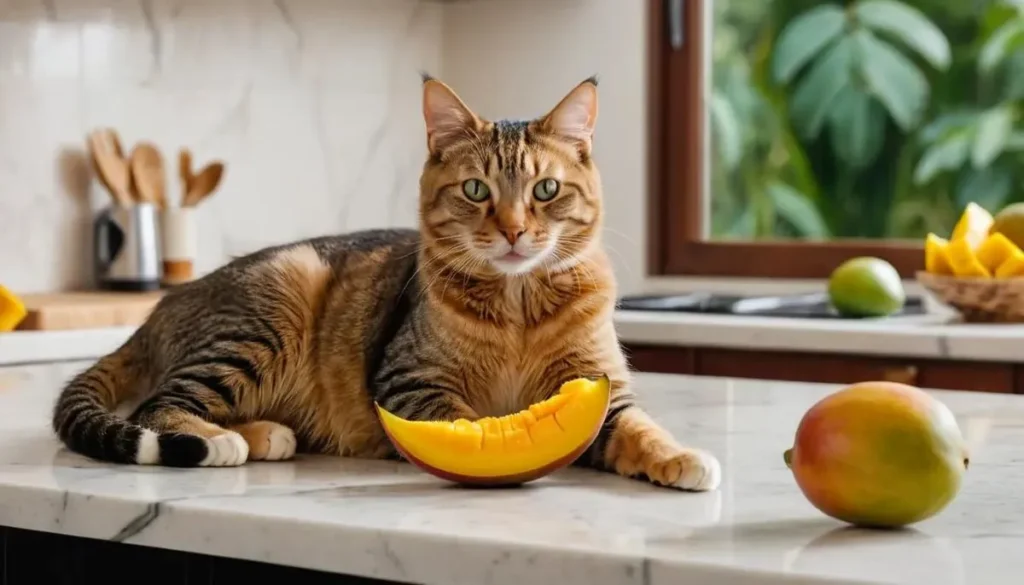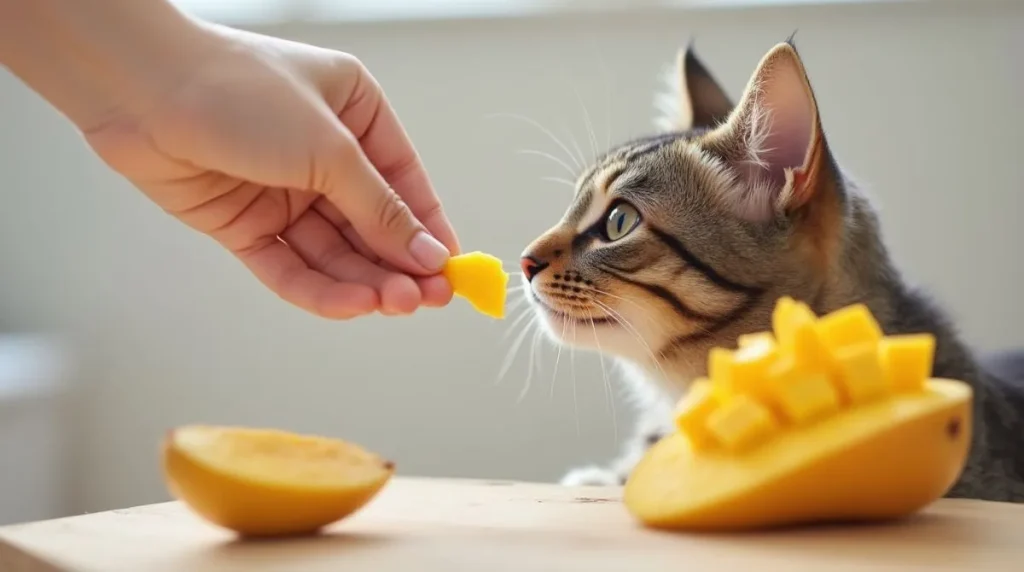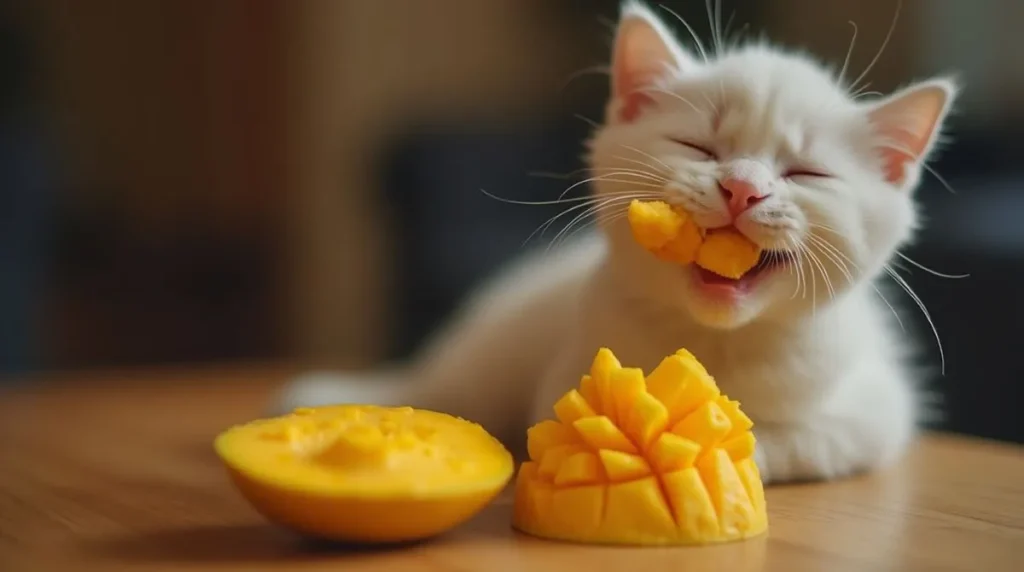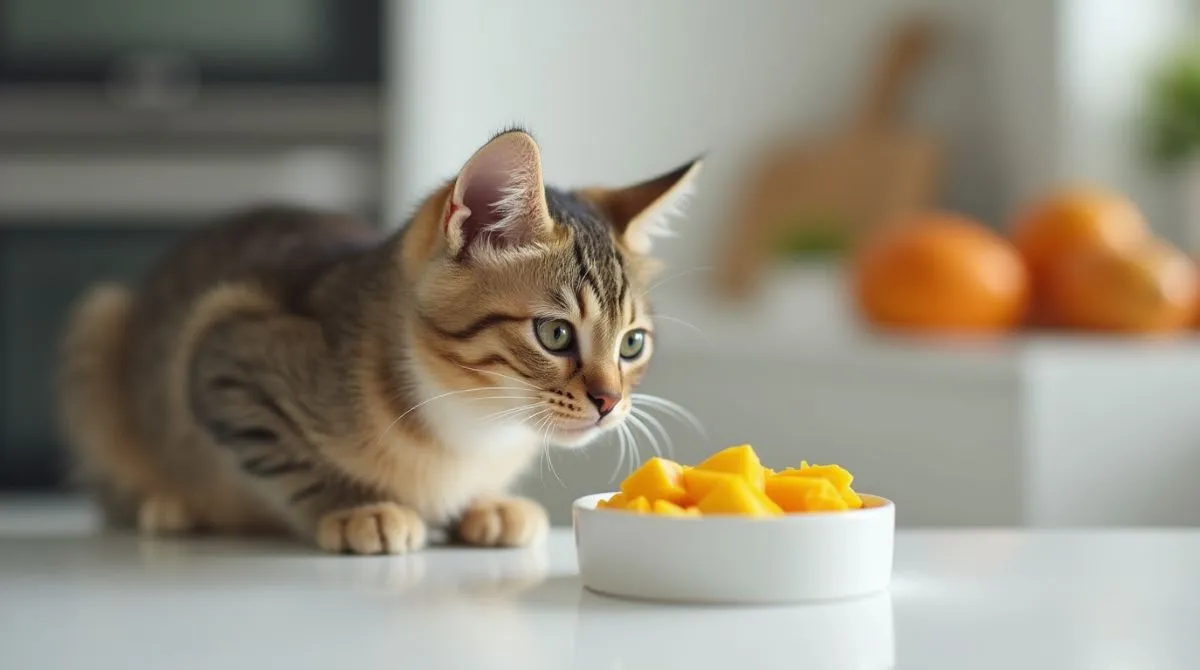Can Cats Eat Mango? If you’ve ever enjoyed a juicy mango snack and wondered whether your feline friend can share this tropical fruit, you’re not alone. Mango is packed with essential nutrients like vitamins and fiber, making it a popular choice among health-conscious humans. But is it safe for cats? While mango can offer some benefits, there are crucial safety guidelines and potential risks to consider. In this complete guide, we’ll explore whether mango is a safe treat for your cat, its possible health benefits, and 5 important tips to keep your furry friend happy and healthy.
Table of Contents
Is Mango Safe for Cats?
Nutritional Value of Mango for Cats
Mango is a tropical fruit rich in vitamins A, C, and E, along with fiber and antioxidants. While cats are obligate carnivores and don’t require fruits or vegetables for a balanced diet, small amounts of mango can provide a minor nutrient boost. Vitamins in mango support the immune system and promote healthy skin and fur. The fiber content, when given in moderation, may aid digestion and help prevent constipation in cats. However, since cats cannot fully process plant-based nutrients like humans, mango should only be an occasional treat.
Can Cats Digest Mango?
Cats have a digestive system primarily designed to process animal protein. Although they can digest small portions of fruits like mango, they lack the necessary enzymes to break down large amounts of plant matter effectively. Feeding too much mango can lead to digestive discomfort, including diarrhea or bloating. Therefore, it’s essential to serve mango in small, manageable portions to ensure it doesn’t upset your cat’s stomach.
Is Mango Skin or Seed Harmful to Cats?
Yes, mango skin and seeds are potentially harmful to cats. The skin is tough and difficult to digest, which could cause gastrointestinal blockages. Additionally, mango skin may contain pesticide residues, posing a risk if not thoroughly washed or peeled. The seed (pit) inside a mango is large and hard, presenting a serious choking hazard. It’s also mildly toxic, as it contains compounds similar to cyanide. Always peel the mango and remove the seed before offering it to your cat to ensure maximum safety.

Benefits of Feeding Mango to Cats
Rich Source of Vitamins
Mango contains several essential vitamins, including vitamins A, C, and E. While cats don’t need large amounts of these vitamins from plant-based sources, a small piece of mango can offer a gentle boost to their immune system. Vitamin A plays a key role in supporting optimal eyesight and encouraging healthy skin. Although cats synthesize vitamin C naturally, an extra dose from mango may help with overall immune support, especially for older cats or those recovering from illness.
Provides Hydration
Mango has a high water content, which can help keep your cat hydrated, particularly during hot weather or if they don’t drink much water. Since cats are prone to urinary tract issues when dehydrated, offering water-rich treats like mango in small amounts can be beneficial. However, remember that mango should only complement their primary water intake and never replace it.
Occasional Fiber Boost
Although cats don’t require fiber in their diet like herbivores, a small amount can aid in digestion. The fiber in mango can help regulate bowel movements, prevent constipation, and improve overall gut health. Cats that occasionally experience mild digestive issues might benefit from a tiny portion of mango as a natural fiber supplement. However, too much fiber can lead to loose stools, so moderation is key.
Antioxidants for Cellular Health
Mango is rich in antioxidants, which help fight free radicals and support overall cellular health. Antioxidants play a vital role in reducing inflammation and may contribute to long-term health benefits, such as improved skin condition and reduced signs of aging. Although cats primarily get antioxidants from meat sources, adding a small amount of mango occasionally can provide additional protection against oxidative stress.
Potential Risks of Giving Mango to Cats
High Sugar Content
Mango is naturally sweet and contains a significant amount of sugar. While the sugars in mango are natural, cats do not have a dietary requirement for sugar, and consuming too much can lead to obesity, diabetes, or other metabolic issues over time. Even a small amount of mango should be treated as an occasional treat, ensuring that the overall sugar intake remains low to protect your cat’s long-term health.
Digestive Upset
Cats have sensitive digestive systems that are optimized for processing meat rather than fruits or vegetables. Feeding too much mango can lead to gastrointestinal issues, including diarrhea, vomiting, or bloating. Some cats may have difficulty digesting mango’s fiber content, resulting in discomfort. It’s crucial to introduce mango in very small amounts and monitor your cat’s reaction before offering it again.
Choking Hazards from Mango Skin and Seed
The skin of a mango is tough and difficult to chew, posing a potential choking hazard if your cat tries to eat it. Additionally, mango skin may contain pesticide residues, which could be harmful if ingested. The seed, or pit, inside a mango is even more dangerous, as it is large, hard, and can block the airways or cause an intestinal obstruction. Always peel the mango and remove the seed before serving it to your cat to minimize the risk.
Potential Allergic Reactions to mango
While rare, some cats may experience allergic reactions after consuming mango. Allergic reactions may present as swelling, itching, or trouble breathing. If you notice any unusual behavior or signs of discomfort after feeding mango, it’s best to avoid offering it in the future and consult your veterinarian. Introducing mango in tiny amounts initially can help you determine whether your cat has any sensitivity to the fruit.
Overfeeding Risks
Even though mango is considered safe in small portions, overfeeding can lead to unintended health consequences. Cats thrive on a balanced, protein-rich diet, and feeding too much fruit can disrupt their nutritional balance. Overconsumption of mango or any other treat can reduce your cat’s appetite for its regular, nutritionally complete meals. Stick to occasional, tiny portions to keep your cat healthy while allowing them to enjoy this tropical snack.
How to Safely Prepare Mango for Your Cat

Remove the Skin and Seed
Before offering mango to your cat, it’s essential to remove the skin and seed. Mango skin is not only tough and difficult for cats to chew but may also contain pesticide residues that could harm your pet. The large seed (pit) inside the mango poses a choking risk and can cause digestive blockages if swallowed. Always peel the mango completely and carefully discard the seed to ensure your cat only consumes the soft, edible flesh.
Cut into Small, Bite-Sized Pieces
Once the mango is peeled and the seed is removed, cut the fruit into small, bite-sized pieces that are easy for your cat to chew and swallow. Big pieces of mango can create a choking risk, particularly for smaller cats. Offering small pieces also helps you control portion sizes, ensuring that your cat doesn’t consume too much mango in one sitting.
Serve in Moderation
Mango should only be an occasional treat for your cat. Even though it contains beneficial nutrients, its high sugar content makes it unsuitable for regular consumption. Offering mango once in a while, in small amounts, ensures your cat gets the taste without any adverse health effects. A few small pieces are more than enough to satisfy your cat’s curiosity without compromising its diet.
Avoid Adding Any Seasoning or Toppings
Cats should only eat plain, unseasoned mango. Avoid adding any sugar, salt, or toppings like cream or syrup, as these can be harmful to your cat. Seasonings and artificial sweeteners, in particular, can lead to digestive issues or even toxicity in cats. Always serve mango in its natural form to keep it safe and healthy for your pet.
Monitor Your Cat After Feeding
Whenever introducing a new food to your cat, including mango, it’s important to monitor their behavior and health afterward. Some cats may have an allergic reaction or experience digestive discomfort. Look for warning signs such as vomiting, fatigue, or diarrhea. If your cat reacts negatively, discontinue feeding mango and consult your veterinarian.
Other Fruits Safe for Cats
Apples
Apples, when served without seeds or core, can be a safe and healthy snack for cats. They are rich in fiber and vitamin C, making them a great treat for digestive health and immune system support. However, it’s crucial to remove the seeds, as they contain small amounts of cyanide, which is toxic to cats. Always offer apples in thin, bite-sized slices to prevent choking.
Blueberries
Blueberries are an excellent fruit option for cats because they are packed with antioxidants, vitamins, and fiber. Their small size makes them easy for cats to eat, and they can even promote urinary tract health. Offering a few fresh blueberries occasionally can be a fun and nutritious treat. Avoid any sweetened or processed versions, as added sugar can harm your cat.
Watermelon
Watermelon is a hydrating fruit that can be a refreshing treat for cats, especially on hot days. Its high water content helps keep cats hydrated, while its sweet flavor might appeal to their curiosity. Be sure to remove the seeds and rind before serving, as these parts can pose a choking hazard or cause digestive upset. Serve only the soft, seedless flesh in small chunks.
Strawberries
Strawberries, in small quantities, can be a safe and tasty fruit for cats. They are high in vitamin C and antioxidants, which support overall health. However, due to their sugar content, strawberries should only be offered occasionally and in moderation. Make sure to wash the fruit thoroughly and cut it into small pieces to avoid choking.
Bananas
Bananas are another fruit that can be safely offered to cats in moderation. They are rich in potassium and fiber, which support heart health and digestion. Due to their high carbohydrate content, bananas should only be given as a rare treat to prevent unnecessary weight gain. Slice bananas into small, easy-to-chew pieces before feeding them to your cat.

FAQs About Can Cats Eat Mango?
Can kittens eat mango?
While kittens are generally more sensitive to new foods, they can eat mango in small amounts once they start transitioning to solid foods. Ensure that the mango is peeled, seedless, and cut into very small pieces to avoid choking. Always consult your veterinarian before introducing new foods to a kitten’s diet, especially if they have a sensitive stomach.
Is mango a healthy treat for cats?
Mango contains beneficial nutrients such as fiber, vitamins (A, C), and antioxidants, which can support a cat’s immune system and digestive health. However, due to its natural sugar content, mango should only be an occasional treat and not a regular part of your cat’s diet. The high sugar content may lead to weight gain or upset stomachs if consumed in large quantities.
Is mango good for cats with sensitive stomachs?
Mango can be a tricky fruit for cats with sensitive stomachs due to its fiber content. For cats with digestive issues or food sensitivities, it’s best to avoid mango or introduce it in tiny quantities. If your cat shows any signs of discomfort after eating mango, discontinue giving it and consult your veterinarian.
Can I feed mango to my cat every day?
Mango should never be fed to your cat every day. Due to its high sugar content, it can contribute to weight gain and digestive issues if given too frequently. Mango should only be offered as an occasional treat, not a regular part of your cat’s diet. Stick to small portions, and provide a balanced diet focused on high-quality cat food.
Conclusion: Can Cats Eat Mango?
In summary, can cats eat mango? Yes, in small amounts and as an occasional treat, mango can be a safe and enjoyable snack for your feline friend. Packed with vitamins, fiber, and antioxidants, it offers some health benefits when served correctly. However, it’s crucial to peel the mango, remove the seed, and offer only small, bite-sized pieces to prevent choking or digestive issues. Always monitor your cat after introducing new foods to ensure they tolerate it well. Remember, moderation is key—while mango is safe, it should never replace a well-balanced, protein-rich cat diet. Treat your cat to mango responsibly, and they may enjoy a tasty tropical delight!

